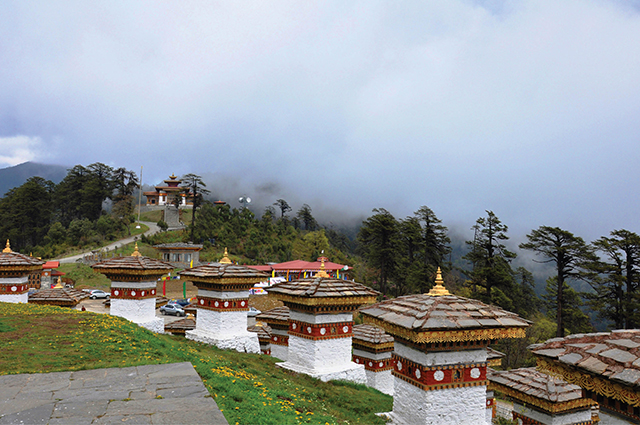
In Bhutan, the ruins are always surrounded by old forests
I have seen that in several places that I have been to.
In Bhutan, the land of Eden on the side of the Himalaya, I was lucky enough to witness all the true affection that the people show toward nature. The king of Bhutan once issued an order that when one forest tree was cut down, three new ones should be planted.
Up to 72% of this country’s natural area is covered by dense forests, putting them on the top of the world in this aspect. However, as they are not yet satisfied with that figure, Bhutanese still find many ways to increase the forest coverage every year. Indeed, it is their king that has always been the forerunner in this cause.
Every year, on the anniversary of his coronation or his birthday celebration, instead of treating the people with glorious and magnificent parades, the king would declare it a "social forestry" day. Accordingly, students, teachers, and workers would take the day off to plant millions of trees! Thanks to this special commitment to nature, the people here have enjoyed well a generous return from it.
On the dangerous winding roads that we traveled, although they are steep and rough, we hardly saw any landslides. This should be credited to the ancient forests that extend endlessly on both sides of the road which keep the soil in place. The roads are narrow, but perhaps it is because Bhutanese people do not want to expand them as they know it will cost them a great number of trees along the roads.
The narrow roads may lengthen the travel time, but in return, the forest trees and nature are preserved. It reveals a "slow living" philosophy of Bhutanese that we experienced during the journey.
The lesson of preserving the forests of Bhutan was also learned by King Jigme Singye Wangchuck from the painful experience of their "neighbor" Nepal. The shattered forests in Nepal have led to catastrophes with constant flooding and drought. Therefore, in order not to "follow" the neighbor’s footsteps, the Bhutanese have effortlessly made their country’s forest coverage the highest in the world.
Strangely, after my return from Bhutan, I came across such a "forest consciousness" in a community of ethnic minorities at the towering rocky plateau of Ha Giang – the Pu Péo ethnic group.
This ethnic group is very different in the way they respect nature. In the middle of the immensity of the rocky mountains in Ha Giang, while the H’Mong people can live and die within the rocks, the Pu Peo cannot lead a life without forest. Where there is a Pu Péo community, there are protected forests.
Every year, the worship ritual of the forest god is solemnly performed according to the customary law of this community. And if any Pu Péo member invades the forest, the tribal punishment that he/she faces shall be even higher than the legal penalties.
In the late 70s and early 80s of the last century, amidst the border war, the inhabitants of the bordering areas were relocated to the backline, as were the Pu Péo people. Only for a while, however, regardless of lethal risks, they reverted to live with the forests on the rocky mountains - their homeland. They simply cannot live away from forests.
In the days of wandering through the Pu Péo villages, I realized that the way they respect Mother Nature and respect this old jungle on the rocky plateau is quite similar to the spirit of the Bhutanese that I met. That respect is almost the utmost they could have towards nature. This explains why when we are in a house of a Pu Péo, it seems like we are “time-traveling” back to the previous century - when the earth was not polluted and the human souls were pure.
When thinking about a green Hue, I suddenly thought of green and cool garden houses. Unlike fruity gardens of the South or intensively cultivated farms of the North, Hue gardens feature fruits that are tasty enough for children to retain their childhood memories, flowers that are fragrant enough for the delicate teapots served in the quiet yard, and fencing rows of fence bushes (che tau) that are green and deep enough to disconnect the owners from the hustle and bustle of the outside world upon their passing the gate.
Hue used to be peaceful like that. And now, the garden houses of this type, whose roofs are mossy and dusty, remain in shape regardless of the severity of time and weather, should be shielded from the modernization whirlwind. In the previous years of living in Hue, every time I passed through the big streets, I could often see a house, a gate or a green shade of Hue from the old-time, proudly standing amidst the busy streets and haughtily challenging the chaos. When so, I usually got marveled and stopped for a while so as I could film the scenery with my mind and live in a brief hope that all the earthly anxieties would be driven away the day after.
The clean and green movements that Hue people are striving in would help bring back a state of green to the city, which will ultimately restore the calmness of the birds’ songs and revive the tranquility of the old-time flowers. For, after all, Hue is always one of a kind.
The green of Hue reflects not only its environment, but also its flowers and plants, and its sunny and rainy seasons.
It is also an eternal abode for the souls of Hue, as always!
Story and photo: Le Duc Duc